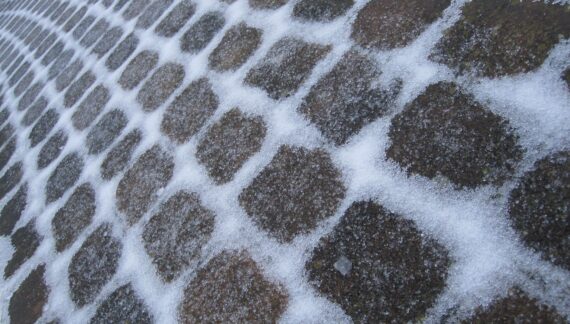Getting your garden ready for Winter. If you would like your garden to look great in the Spring then carrying out some work in the Winter to prepare your garden for the cold spell will really help it. Here are some tasks to consider undertaking: 1. Give your paving and paths a good clean. Take off all the furniture and planters, clear out all the leaves, give it a good brush down and a clean with some soapy water and a stiff broom. If you have a pressure washer this will make the job a lot quicker and easier for you. 2. Give your decking a good brush down, firstly take off any chairs or tables or planters, then getting into the corners to remove any dead leaves or debris. Finally give it a wash down with some soapy water and a stiff broom or a pressure washer if you have one available. 3. Take a walk around your garden and take a good look around the boundary of your fences to check that the posts are still in good order and the fence panels do not need repair or for any to be replaced. 4. Lighting will really brighten up your garden in the Winter so is something to consider adding if not already there. The nights draw in fairly early now. 5. For your lawn go over the entire area with a rake to remove thatch and moss allowing it to breath and grow. Aerate and give it an Autumn feed. 6. Trim your hedges before the frost hits. 7. For your trees remove any dead or damaged branches. 8. Tidy up your borders by removing any weeds or dead foliage and leaves. Remove any annual plants and cut back herbaceous perennials. 9. If you have a compost bin now would be a good time to clear it out and spread it across your beds ready for the Spring. This also helps to make the beds look a little more presentable over the Winter. 10. Now is the time to plant out your Spring bulbs before the Winter kicks in. Once Spring arrives your garden will be alive with colour. 11. Take a look at your shed or greenhouse to see if the wood needs a coat of paint or any repairs need to be carried out. Now is a good time to give it a tidy up and clean inside and get all your tools in order. Consider adding shelving to make things easier to find. 12. For any delicate plants wrap them up in fleece ready for the Winter or move them to the greenhouse or conservatory. 13. If you have a pond try to keep it clear of leaves and place a ball in there to float on the surface to stop it freezing over completely. 14. If snow does arrive, and it seems to be more likely each year, then knock the snow that is resting on the leaves of your plants to try to prevent severe damage. If you are thinking of a new project for your garden like adding in a decking area in a sunny corner or a patio area to create a great entertaining space then now is a good time to get the work carried out whilst the garden isn’t getting as much use. If you would like to discuss please email office@eastlondonlandscapes.com or call 020 3633 6413 to arrange a free consultation and a quote for the works.
Getting Your Garden Ready For Winter
The bright autumn colours and arrival of the first frosts emphasise the need to get gardens ready for winter. Temperatures can drop fast, while wind and rain can quickly cause problems. Checking the condition of fences has to be a priority. High winds often blow down fences and this not only affects your garden, but your security as well. Trying to replace those fences in a hurry can be difficult. Taking action in advance reduces the risk of problems. Look closely at all sections of the fence and ensure that it is firmly fixed, that there are no rotten posts and that the overall condition is good. Trellis sections attached to fences should be attached firmly as the weight of climbing plants can make them top heavy. Any damaged sections should be replaced before winter weather can take its toll. Equally important is the need to check the condition of garden buildings to make sure that there are no problems. Damaged glass in greenhouses should be replaced. Make sure that there are no damaged or worn areas on decking and patios. These can become slippery with algae in wintertime. Thoroughly clean all surfaces and undertake replacements as necessary. Sweep up leaves that fall onto paths quickly. Although pretty, they can become a hazard as they rot down. Check the condition of tall trees and shrubs to make sure there are no loose or dying branches. High winds can quickly bring these branches down. If they fall across telephone or electric wires you can find yourself without those essential services for a while. Removing the potential hazards in advance does make life a lot easier. Lawns need extra care as winter approaches. Grass will continue growing until quite late in the year so mowing will continue to be necessary. Remove any grass that is growing into borders and flowerbeds, or overlying paths and driveways. Bare patches of lawn should be replaced with new turf. Aerate the lawn carefully to make sure that winter rain and snow does not result in surface water forming on top of the lawn. In some circumstances, this can lead to flooding and the development of boggy patches. If your lawn is in an overall bad condition, it is worth considering replacing it now as it will give the new turf time to establish itself before the really bad weather arrives. If you would like to discuss any of the above tasks to get your garden ready please get in touch via our website www.eastlondonlandscapes.com or send us an email to office@eastlondonlandscapes.com.
New Lawn – Aftercare
When you have a new lawn laid you need to give it alot of aftercare to help it bed in well and stay healthy. Below is some advice: Walk on the new lawn as little as possible for the first six weeks or so to allow the roots to bed down. Try to water twice a day (first thing in the morning and early evening). Do not water in the hot sun to avoid burning the grass. Water areas near buildings and paths more often where reflected heat dries out the turf faster. Keep turf roots damp until the turf has taken root and cannot be lifted (usually 3 to 4 weeks).Be aware that windy days will dry out the turf even more quickly! Don’t mow it until it’s rooted in well – test by gently tugging a corner to see if it’s stuck down. Set your mower to about 1 1/2″ high and make sure the blades are sharp. It is harmful to remove more than 1/3 the height of the grass at one cutting. This can produce a “scalped” appearance and stress the lawn. Fertilise about 6 weeks after being laid. Keep it well watered and fertilised throughout the first year. In the Autumn spike the grass to help aerate it. Then the following April treat it with lawn sand (apply it with a lawn spreader) to keep moss and weeds at bay. Turf is a living plant and requires as much T.L.C. as any other garden plant and more so in establishment!





